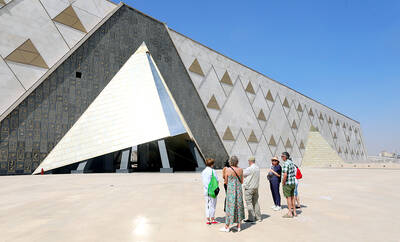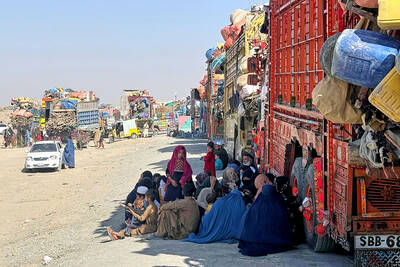China has built a land-based prototype nuclear reactor for a large surface warship, in the clearest sign yet Beijing is advancing toward producing the nation’s first nuclear-powered aircraft carrier, according to a new analysis of satellite imagery and Chinese government documents provided to The Associated Press.
There have long been rumors that China is planning to build a nuclear-powered aircraft carrier, but the research by the Middlebury Institute of International Studies in California is the first to confirm it is working on a nuclear-powered propulsion system for a carrier-sized surface warship.

Photo: AP
Why is China’s pursuit of nuclear-powered carriers significant?
China’s navy is already the world’s largest numerically, and it has been rapidly modernizing. Adding nuclear-powered carriers to its fleet would be a major step in realizing its ambitions for a true “blue-water” force capable of operating around the globe in a growing challenge to the US.
Nuclear carriers take longer to build than conventional carriers, but once in operation they are able to stay at sea for much longer because they do not need to refuel, and there is more room on board for fuel and weapons for aircraft, thus extending their capabilities. They are also able to produce more power to run advanced systems.
Right now, only the US and France have nuclear-powered carriers. The US has 11 in total, which allows it to keep multiple strike groups deployed around the world at all times, including in the Indo-Pacific. However, the Pentagon is growingly increasingly concerned about China’s rapid modernization of its fleet, including the design and construction of new carriers.
China has three carriers, including the new Type 003 Fujian, which was the first both designed and built by China. It has said work is under way on a fourth, but it has not announced whether that would be nuclear or conventionally powered.
The modernization aligns with China’s “growing emphasis on the maritime domain and increasing demands” for its navy “to operate at greater distances from mainland China,” the US Department of Defense said in its most recent report to Congress on China’s military.
How did researchers conclude China has built a prototype reactor for a carrier?
Middlebury researchers were initially investigating a mountain site outside the city of Leshan in the southwest Chinese province of Sichuan over suspicions that China was building a reactor to produce plutonium or tritium for weapons. Instead, they said they determined that China was building a prototype reactor for a large warship.
The conclusion was based on a wide variety of sources, including satellite images, project tenders, personnel files and environmental impact studies.
The reactor is housed in a new facility built at the site known as Base 909, which is under the control of the Nuclear Power Institute of China.
Documents indicating that China’s 701 Institute, which is responsible for aircraft carrier development, procured reactor equipment “intended for installation on a large surface warship,” as well as the project’s “national defense designation” helped lead to the conclusion the sizeable reactor is a prototype for a next-generation aircraft carrier.
What does China say?
Chinese President Xi Jinping (習近平) has tasked defense officials with building a “first-class” navy and becoming a maritime power as part of his blueprint for the country’s great rejuvenation.
China’s most recent white paper on national defense, dated 2019, said the Chinese navy was adjusting to strategic requirements by “speeding up the transition of its tasks from defense on the near seas to protection missions on the far seas.”
Sea trials had not even started for the new Fujian aircraft carrier in March when Yuan Huazhi (袁華智), political commissar for China’s People’s Liberation Army Navy, confirmed the construction of a fourth carrier.
Asked if it would be nuclear-powered, he said at the time that would “soon be announced,” but so far it has not been.
Neither the Chinese defense ministry nor its foreign ministry responded to requests for comment.
Even if the carrier that has been started is likely to another conventionally powered Type 003 ship, experts say Chinese shipyards have the capability to work on more than one carrier at a time, and that they could produce a new nuclear-powered vessel concurrently.

With much pomp and circumstance, Cairo is today to inaugurate the long-awaited Grand Egyptian Museum (GEM), widely presented as the crowning jewel on authorities’ efforts to overhaul the country’s vital tourism industry. With a panoramic view of the Giza pyramids plateau, the museum houses thousands of artifacts spanning more than 5,000 years of Egyptian antiquity at a whopping cost of more than US$1 billion. More than two decades in the making, the ultra-modern museum anticipates 5 million visitors annually, with never-before-seen relics on display. In the run-up to the grand opening, Egyptian media and official statements have hailed the “historic moment,” describing the

‘CHILD PORNOGRAPHY’: The doll on Shein’s Web site measure about 80cm in height, and it was holding a teddy bear in a photo published by a daily newspaper France’s anti-fraud unit on Saturday said it had reported Asian e-commerce giant Shein (希音) for selling what it described as “sex dolls with a childlike appearance.” The French Directorate General for Competition, Consumer Affairs and Fraud Control (DGCCRF) said in a statement that the “description and categorization” of the items on Shein’s Web site “make it difficult to doubt the child pornography nature of the content.” Shortly after the statement, Shein announced that the dolls in question had been withdrawn from its platform and that it had launched an internal inquiry. On its Web site, Le Parisien daily published a

‘NO WORKABLE SOLUTION’: An official said Pakistan engaged in the spirit of peace, but Kabul continued its ‘unabated support to terrorists opposed to Pakistan’ Pakistan yesterday said that negotiations for a lasting truce with Afghanistan had “failed to bring about a workable solution,” warning that it would take steps to protect its people. Pakistan and Afghanistan have been holding negotiations in Istanbul, Turkey, aimed at securing peace after the South Asian neighbors’ deadliest border clashes in years. The violence, which killed more than 70 people and wounded hundreds, erupted following explosions in Kabul on Oct. 9 that the Taliban authorities blamed on Pakistan. “Regrettably, the Afghan side gave no assurances, kept deviating from the core issue and resorted to blame game, deflection and ruses,” Pakistani Minister of

UNCERTAIN TOLLS: Images on social media showed small protests that escalated, with reports of police shooting live rounds as polling stations were targeted Tanzania yesterday was on lockdown with a communications blackout, a day after elections turned into violent chaos with unconfirmed reports of many dead. Tanzanian President Samia Suluhu Hassan had sought to solidify her position and silence criticism within her party in the virtually uncontested polls, with the main challengers either jailed or disqualified. In the run-up, rights groups condemned a “wave of terror” in the east African nation, which has seen a string of high-profile abductions that ramped up in the final days. A heavy security presence on Wednesday failed to deter hundreds protesting in economic hub Dar es Salaam and elsewhere, some